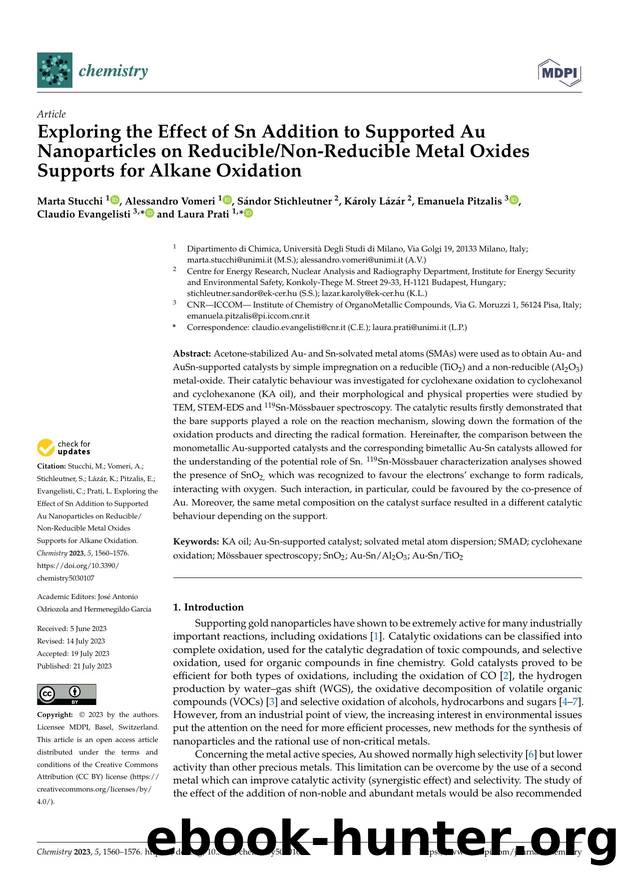Exploring the Effect of Sn Addition to Supported Au Nanoparticles on ReducibleNon-Reducible Metal Oxides Supports for Alkane Oxidation by unknow

Author:unknow
Format: pdf
Tags: Acetone-stabilized Au- and Sn-solvated metal atoms (SMAs) were used as to obtain Au- and AuSn-supported catalysts by simple impregnation on a reducible (TiO2) and a non-reducible (Al2O3) metal-oxide. Their catalytic behaviour was investigated for cyclohexane oxidation to cyclohexanol and cyclohexanone (KA oil), and their morphological and physical properties were studied by TEM, STEM-EDS and 119Sn-Mössbauer spectroscopy. The catalytic results firstly demonstrated that the bare supports played a role on the reaction mechanism, slowing down the formation of the oxidation products and directing the radical formation. Hereinafter, the comparison between the monometallic Au-supported catalysts and the corresponding bimetallic Au-Sn catalysts allowed for the understanding of the potential role of Sn. 119Sn-Mössbauer characterization analyses showed the presence of SnO2, which was recognized to favour the electrons’ exchange to form radicals, interacting with oxygen. Such interaction, in particular, could be favoured by the co-presence of Au. Moreover, the same metal composition on the catalyst surface resulted in a different catalytic behaviour depending on the support., KA oil; Au-Sn-supported catalyst; solvated metal atom dispersion; SMAD; cyclohexane oxidation; Mössbauer spectroscopy; SnO2; Au-Sn/Al2O3; Au-Sn/TiO2
Download
This site does not store any files on its server. We only index and link to content provided by other sites. Please contact the content providers to delete copyright contents if any and email us, we'll remove relevant links or contents immediately.
Alchemy and Alchemists by C. J. S. Thompson(3450)
The Elements by Theodore Gray(2998)
The Club by A.L. Brooks(2862)
How to Make Your Own Soap by Sally Hornsey(2829)
Drugs Unlimited by Mike Power(2545)
Wheels of Life by Anodea Judith(2098)
Cracking the LSAT, 2012 Edition by Princeton Review(1883)
Cracking the Sat French Subject Test, 2013-2014 Edition by The Princeton Review(1829)
Perfume by Jean-Claude Ellena(1782)
The Flavor Matrix by James Briscione(1775)
The Cosmic Machine: The Science That Runs Our Universe and the Story Behind It by Scott Bembenek(1726)
Quantitative and Pattern Recognition Analyses of Five Marker Compounds in Raphani Semen using High-Performance Liquid Chromatography by Unknown(1681)
MCAT Physics and Math Review by Princeton Review(1637)
1000 Multiple-Choice Questions in Organic Chemistry by Organic Chemistry Academy(1621)
The Thing Around Your Neck by Chimamanda Ngozi Adichie(1600)
Handbook of Modern Sensors by Jacob Fraden(1544)
Cracking the SAT Premium Edition with 6 Practice Tests, 2017 by Princeton Review(1539)
Synchrotron Light Sources and Free-Electron Lasers by Eberhard J. Jaeschke Shaukat Khan Jochen R. Schneider & Jerome B. Hastings(1524)
A is for Arsenic: The Poisons of Agatha Christie (Bloomsbury Sigma) by Kathryn Harkup(1507)
